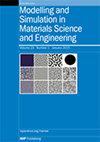纳米颗粒滑动不锈钢微观磨损机理研究
IF 2.4
4区 材料科学
Q3 MATERIALS SCIENCE, MULTIDISCIPLINARY
Modelling and Simulation in Materials Science and Engineering
Pub Date : 2023-07-06
DOI:10.1088/1361-651X/ace4e3
引用次数: 1
摘要
为了揭示纳米颗粒滑动过程中304不锈钢的纳米尺度摩擦行为和磨损机理,采用分子动力学模拟方法研究了滑动速度和滑动深度对304不锈钢表面形貌、温度、机械力、摩擦系数和亚表面损伤(SSD)的影响。结果表明,在滑动过程中,原子在滑动槽两侧对称堆积。随着磨粒压痕深度的增加,滑动摩擦力、摩擦系数、缺陷原子、相变程度和位错线长度均增加,而滑动速度对其影响不大。随着磨料压痕深度的增加,滑动区温度和挤压效应明显增加,导致工件表面损伤更加严重。滑动深度为20 Å的损伤层在滑动速度为100 m s−1时达到57.2 Å左右,在滑动距离为50 Å时达到最大值41.1 Å。而随着滑动速度的增加,表层SSD层的厚度下降,其滑动深度为20 Å。微观原子演化揭示了不锈钢的纳米滑动磨损机理。本文章由计算机程序翻译,如有差异,请以英文原文为准。
Study on the microscopic wear mechanism of nanoparticles sliding stainless steel
In order to reveal the nanoscale friction behavior and wear mechanism of 304 stainless steel during nano particles sliding, this study investigated the effects of sliding velocity and depth on the surface morphology, temperature, mechanical forces, coefficient of friction and sub-surface damage (SSD) of stainless steel by employing molecular dynamics simulations. The results demonstrate that the atoms symmetrically stack on both sides of the sliding grooves during the sliding process. Sliding friction, friction coefficient, defective atoms, phase changing degree and the length of dislocation line increases as the indentation depth of the abrasives, while sliding velocity had little impact on them. Temperature in sliding area and the squeezing effect distinctly increases with the indentation depth the abrasives, which leads more serious damage on the surface of workpiece. The damage layer with a sliding depth of 20 Å can reach about 57.2 Å at a sliding velocity of 100 m s−1, and it has a maximum value of 41.1 Å at a sliding distance of 50 Å. However, increasing sliding velocity can decline the surface SSD layer, which was at a sliding depth of 20 Å. The microscopic atoms evolution presented in the study uncovers the nano-sliding wear mechanism of stainless steel.
求助全文
通过发布文献求助,成功后即可免费获取论文全文。
去求助
来源期刊
CiteScore
3.30
自引率
5.60%
发文量
96
审稿时长
1.7 months
期刊介绍:
Serving the multidisciplinary materials community, the journal aims to publish new research work that advances the understanding and prediction of material behaviour at scales from atomistic to macroscopic through modelling and simulation.
Subject coverage:
Modelling and/or simulation across materials science that emphasizes fundamental materials issues advancing the understanding and prediction of material behaviour. Interdisciplinary research that tackles challenging and complex materials problems where the governing phenomena may span different scales of materials behaviour, with an emphasis on the development of quantitative approaches to explain and predict experimental observations. Material processing that advances the fundamental materials science and engineering underpinning the connection between processing and properties. Covering all classes of materials, and mechanical, microstructural, electronic, chemical, biological, and optical properties.

 求助内容:
求助内容: 应助结果提醒方式:
应助结果提醒方式:


